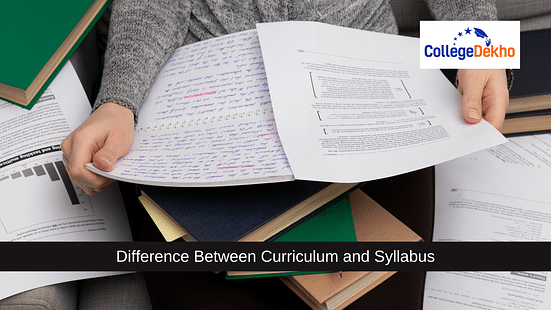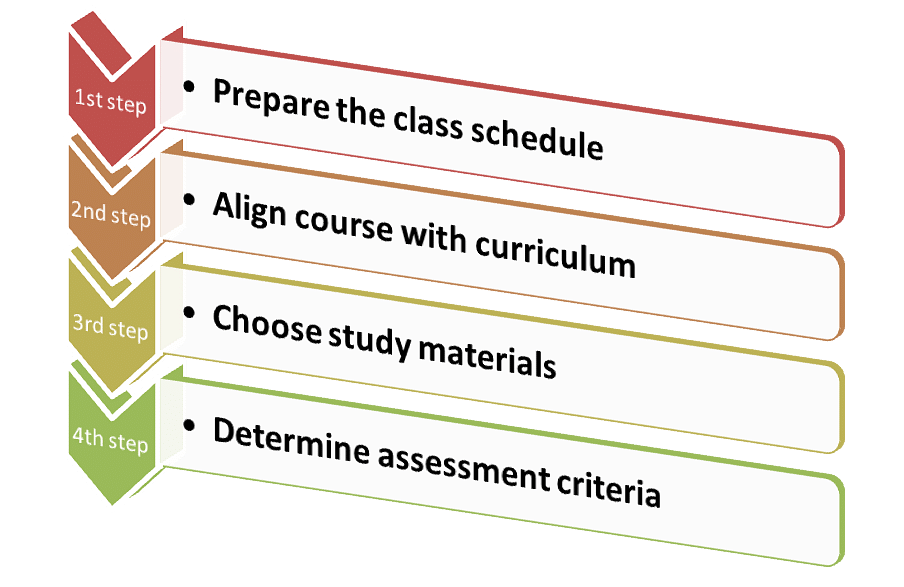When used interchangeably, students get confused between the difference between curriculum and syllabus. Check out this article to clear all your doubts regarding 'syllabus' and 'curriculum'!
- Difference Between Curriculum vs Syllabus: Overview
- What is a Curriculum?
- What is a Syllabus?
- Difference Between Curriculum and Syllabus: Key Pointers
- Difference Between Curriculum and Syllabus: Developing a Syllabus
- Difference Between Curriculum and Syllabus: Designing a Curriculum
- Relationship Between Curriculum, Syllabus and Textbook
- Faqs

Difference Between Curriculum and Syllabus: Curriculum and syllabus are two important terms that students come across in their education journey. The main difference between curriculum and syllabus lies in the fact that a particular subject's syllabus is a part of a course or curriculum. A curriculum is a combination of the syllabus of all subjects, course design, class timetable, and lesson plans for a subject. While the syllabus outlines the topics and concepts to be covered, the curriculum encompasses how a particular subject or course will be taught. Often, these terms are used interchangeably, but they are fundamentally different. Understanding the difference between syllabus and curriculum provides a more detailed insight into the structure of an academic program. Let's delve into the discussion of curriculum vs syllabus and explore their key differences.
Also Read:
Difference Between Curriculum vs Syllabus: Overview
The curriculum includes all the content outlined by an education board for a specific course over a set period. On the other hand, the syllabus provides a summary of the various topics or units that will be taught within a specific subject or discipline under that particular course.
Point of Differences | Curriculum | Syllabus |
|---|---|---|
Definition | A curriculum comprises the courses and content provided by an educational institution. | A syllabus is a detailed list describing the subjects to be taught in a class, such as chapters to be covered. etc. |
Scope | The whole educational program includes various courses, subjects, and their connections. | It concentrates on an individual course or subject within the larger curriculum. |
Settings | It is not easy to make adjustments to the curriculum. | The syllabus can be easily adapted according to the specific requirements of each class. |
Content | The curriculum includes information about courses, goals, methods, and more. | The syllabus lists topics to be covered and provides details about assignments, assessments, and other specifics. |
Long-term vs. Short-term | Concerns long-term educational objectives and learning outcomes spanning an extended period, often years. | Relates to short-term instructional plans, typically for a single academic term or semester. |
Examples | A class 1 school curriculum details the subjects (such as math and science) and learning objectives for each grade level. | A syllabus for a class 11th and 12th Chemistry subject provides information about the topics, readings, assignments, and assessment methods specific to that class. |
What is a Curriculum?
Curriculum acts as a supreme guide to academic content defining the purpose, objectives, and criteria for assessing learners. It is generally curated and regulated by a team of educators hailing from an institution. One can gain a broader understanding of subjects being taught in a particular session or class. Learners and teachers can gain complete insight into the way to help students assimilate the concepts mentioned in the syllabus. The curriculum offers a blueprint of the behaviour, knowledge, skills, performance, and attitude expected from a learner. It focuses on different aspects of the teaching-learning phase including study resources, assignments, mental exercises, teaching methodology, learning objectives, and presentations.
Curriculum can be categorized into three major types that have been discussed below:
- Explicit Curriculum: An explicit curriculum refers to curating and designing a curriculum that is well-planned and structured by keeping the learning objective in mind. It is often evaluated and assessed as a pilot project before being introduced in educational institutes.
- Hidden Curriculum: It does not form part of a planned and well-structured curriculum rather hidden curriculum is what students learn during the teaching process. While imparting education, teachers try to inculcate values like fairness, honesty, etc.
- Excluded or Null Curriculum: An excluded curriculum is the part of the course that a teacher often avoids teaching deliberately or unintentionally. Teachers often find some topics or ideas that might not require detailed descriptions.
What is a Syllabus?
A syllabus unlike a curriculum is descriptive and focuses on the subjects to be taught for a particular academic session. It is determined and structured by an institution or an examination board that includes CBSE, ICSE, or any state boards. Each of the chapters and its respective topics or subtopics are mentioned to help learners grow a fundamental understanding of the subjects included in an academic year. The emphasis of the syllabus is enabling students to assimilate knowledge through the course material.
The syllabus is designed in collaboration with educators, board members, and teachers with a supreme objective to help students grasp the content easily. While selecting chapters and topics, the age of the learners is given relevance. During assessment, teachers ensure that questions are set per the syllabus pattern.
Difference Between Curriculum and Syllabus: Key Pointers
As you embark on your academic journey, you will frequently encounter the terms curriculum and syllabus. For students in various classes, streams, or educational boards, understanding the key differences between curriculum and syllabus is essential, as outlined below:
- Overview: The syllabus zooms in on a particular course or subject, whereas the curriculum covers the entire educational program.
- Goals: The syllabus details topics, content, and learning objectives for a course, while the curriculum establishes broader educational aims.
- Detail Level: The syllabus offers a specific instructional plan, while the curriculum shapes the overall design and structure of learning activities.
- Specificity: The syllabus is more detailed, while the curriculum is more comprehensive and holistic.
- Creation: The syllabus is crafted by individual teachers or departments, while the curriculum is formulated by educational institutions.
- Components: The syllabus primarily highlights content and learning outcomes, whereas the curriculum encompasses content, teaching methods, and assessment strategies.
- Updates: The syllabus can undergo frequent revisions based on changing needs, whereas the curriculum generally has a longer lifespan.
- Timing: The syllabus is typically given to students at the course's start, while the curriculum acts as a framework throughout the program.
- Focus: The syllabus serves as a guide for students and teachers, while the curriculum directs curriculum development and implementation at the institutional level.
- Connection: The syllabus is a subset of the broader curriculum, which includes syllabi for various courses within an educational program.
Difference Between Curriculum and Syllabus: Developing a Syllabus
A syllabus acts as the model for teaching a course or subject that enables students to grasp a concept and achieve success in their academic term. When developing a syllabus, teachers or instructors take into account several factors including the purpose of teaching, the significance of a course, the age of learners, and topics to be taught for a course. Here are some of the steps undertaken for creating and developing a syllabus.

- Prepare the class schedule: Educators responsible for designing the syllabus need to create a schedule to ensure that the course for a particular session is completed within a given time. Instructors can make a list of topics to be covered in ascending order or based on their importance.
- Align course with curriculum: An important pre-requisite when curating a syllabus is to ensure that it perfectly fits the curriculum structure determined by the authorities of a school or college. Educators should decide on the type of course or level of learning necessary for the students.
- Choose study materials: Choosing the right study material forms a crucial part of developing a syllabus. Educators have to determine which textbooks or study materials are required for students. Assessments are done based on suggested textbooks for a course.
- Determine assessment criteria: Assessment is another significant part of syllabus creation. Be it the exams, class assignments, or projects, the syllabus must contain each of the details upon which learners will be tested.
Difference Between Curriculum and Syllabus: Designing a Curriculum
A curriculum unlike a syllabus offers a bigger picture of the education system hence its designing process is pretty vivid and extensive. When developing a curriculum three major components are considered including what to teach, how to teach, and who will teach. The process generally begins with the identification of issues related to teaching followed by a method of evaluation that can help in overcoming the problem. Find the process for designing a curriculum below:
Planning | Content and Method | Implementation |
|---|---|---|
Identifying a problem or concern | List the intended outcome | Develop curriculum |
Appointing a curriculum development team | Choose content | Assess and revise the curriculum |
Analysis of the need for assessment | Curate experiential methods | Recruit educators |
| - | - | Run a pilot project |
| - | - | Implement the curriculum |
Relationship Between Curriculum, Syllabus and Textbook
The relationship between curriculum, syllabus and textbooks is closely intertwined, as these components form an essential part of an academic session. Let's delve into this connection more comprehensively:
- The curriculum establishes the detailed structure of how the syllabus, teaching periods, and recommended study materials will be organized. The syllabus encompasses all the chapters and topics, including reference books, study guides, and additional academic instructions. Subsequently, the textbook follows the guidelines outlined in both the curriculum and syllabus for an academic semester or year.
- Lesson plans for a specific subject are part of the curriculum but are detailed in terms of chapters and topics in the syllabus, and are further studied through textbooks.
- The more organized a curriculum is, the simpler the syllabus will be, making it easier to cover with the aid of textbooks.
- Regarding their formulation, the education board and teachers create the curriculum and syllabus, while academic authors and publishers develop textbooks according to the curriculum and syllabus.
- The curriculum spans an entire year, the syllabus is for a specific academic session like a semester, and textbooks vary based on the syllabus for each session as well as the curriculum for each year.
Now that the difference between curriculum and syllabus has been clearly outlined and understood. Let us also quickly brush over the similarities. A few similarities between curriculum and syllabus are:
- Both have one ulterior goal — teaching.
- Both are designed as per the educational guidelines set by the authorities.
- Both are crucial for the holistic growth of students.
Curriculum and syllabus are two distinct aspects of an educational program. Distinguishing these two concepts essential for educators and students alike to ensure that educational goals are met and learning outcomes are achieved. By now, you should have a fair idea of the possible differences between a curriculum and a syllabus. To ensure you pave the way to a fulfilling academic career, both these concepts play a vital role.
Related Articles:
| CBSE Class 12 Syllabus 2023-24 | CBSE vs ICSE Board |
|---|---|
| ICSE Class 10th Syllabus 2023-24 | UP Board 12th Syllabus 2023-24 |
If you have any queries concerning courses, exams, or syllabus for UG or PG exams, you can post your question at CollegeDekho 's Q&A section or reach us at 1800-572-9877.

















Similar Articles
DU Colleges and Courses with Less than 90% Cut-Off Criteria
CUET Passing Marks for BHU: Category-wise Passing Marks
Bhim Rao Ambedkar College CUET UG Cutoff 2024: Expected Cutoff based on Previous Trends
SAMS Odisha +2 Admission 2024: Merit List (July 20), Selection Process, Top Colleges
Bihar STET 2024: Answer Key (Out), Result, Cutoff
How to Crack AFCAT in 30 Days?